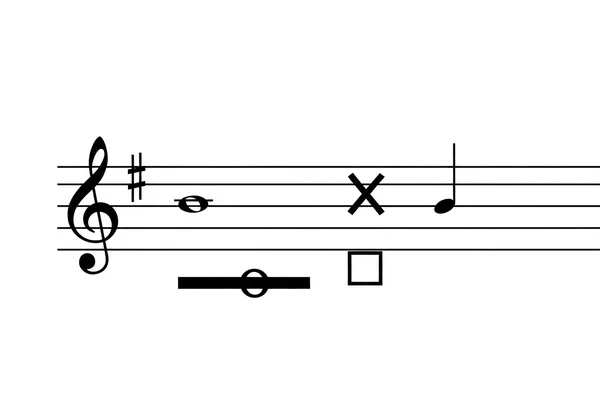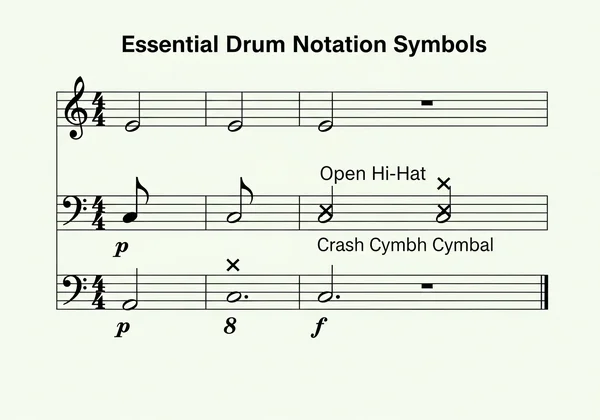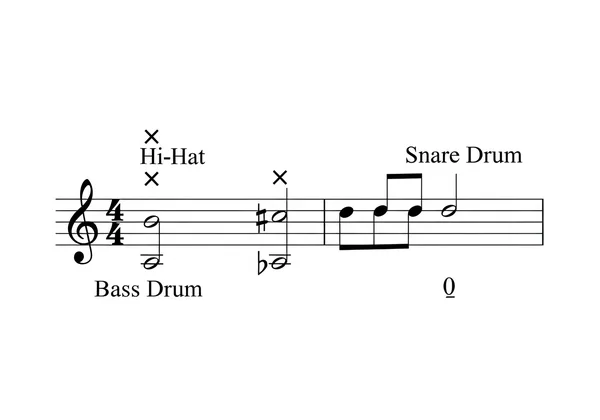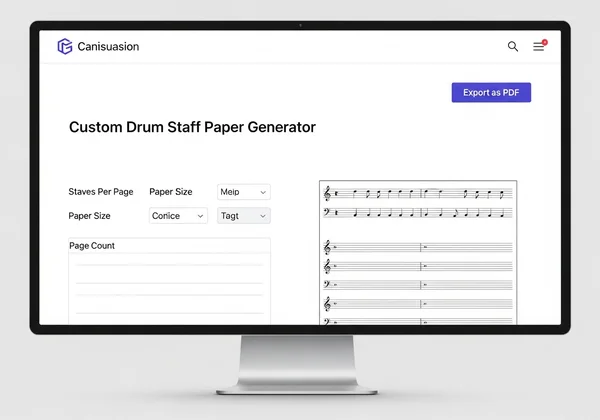Write Your Grooves: The Drummer's Guide to Percussion Notation on Blank Sheet Music
Got a head full of killer drum grooves and fills, but can't seem to get them written down? Don't let those perfect rhythms disappear! This guide will show you exactly how to transform your musical ideas into professional drum sheet music. You'll learn the rhythmic notation essentials to read, write, and share your unique voice, all starting with the free printable staff paper templates readily available online.
Understanding Percussion Notation Basics
Before you can write your masterpiece, it's essential to understand the language of drum music. Unlike melodic instruments that use various clefs like treble or bass to indicate pitch, percussion instruments often use a neutral clef. This system focuses purely on rhythm and which part of the drum kit to play. Let's break down the core components you'll see on your manuscript paper.
The Drum Clef and How to Read the Staff
The first symbol you'll encounter on a line of drum music is the percussion or neutral clef. It looks like a vertical rectangle or two parallel vertical bars. Its job is simple: it tells you that the notes on the following five-line staff represent non-pitched percussion instruments.
The staff itself works like a map of the drum kit. Each line and space is assigned to a specific drum or cymbal. While there are some variations, a standardized layout is widely accepted, making it easier for drummers everywhere to read each other's music. Think of the staff's vertical position as corresponding to the physical position of the instruments in a standard drum kit—low drums are at the bottom, and cymbals are higher up.

Essential Drum Symbols: Notes, Rests, and Dynamics
Once you understand the staff, you need to know what the symbols mean. The core of percussion notation lies in its notes, rests, and dynamics. These elements tell you what to play, when to play it, and how loud to play it.
-
Noteheads: The shape of the notehead often indicates the instrument. A standard round notehead typically represents a drum (like a snare or tom), while an "x" notehead is used for cymbals (like hi-hats or crashes).
-
Stems and Beams: Note stems can point up or down to improve readability, especially when multiple rhythms are happening at once (e.g., hands and feet). Beams group notes like eighth or sixteenth notes together, making complex rhythms easier to decipher at a glance.
-
Rests: Just as important as the notes you play are the moments of silence. Rests tell you when not to play, and they have corresponding durations just like notes (quarter rest, eighth rest, etc.).
-
Dynamics: These symbols, such as p (piano, soft) and f (forte, loud), control the volume and intensity of your playing. They add feeling and expression to the written music.

Common Instrument Placements on the Percussion Staff
Knowing where each instrument lives on the staff is the key to unlocking drum notation. Here is a common and widely used placement system you can start practicing with on your own blank sheet music:
- Bass Drum: Located in the bottom space of the staff.
- Snare Drum: Found on the third space from the bottom. This is your central anchor.
- Floor Tom: Often placed in the second space from the top.
- Mid Tom & High Tom: Reside on the top line and top space, respectively.
- Hi-Hat: Sits just above the top line, typically notated with an "x" notehead. A small circle above the note indicates an open hi-hat.
- Crash Cymbal: Positioned on a ledger line above the staff, also with an "x" notehead.
- Ride Cymbal: Sits on the top line of the staff, distinguished from the high tom by its "x" notehead.
How to Write Drum Music: From Grooves to Fills
Ready for the exciting part? Now that you've got the notation basics down, let's turn your natural rhythms into clear, written music. Think of it as mapping out your drumming ideas so they're easy for anyone (including future you!) to understand. Using a good piece of staff paper is the first step to organizing your thoughts cleanly and professionally.
Notating Basic Drum Patterns and Grooves
Let’s start with a classic rock beat. This simple pattern is the foundation for countless songs. On your staff paper, you'll notate it in 4/4 time like this:
- Hi-Hats: Write eight consecutive eighth notes (with "x" noteheads) above the top staff line, beaming them in groups of two.
- Bass Drum: Add quarter notes on beats 1 and 3 in the bottom space.
- Snare Drum: Add quarter notes on beats 2 and 4 on the third space.
Congratulations, you've just written your first drum groove! The stems for the bass drum should point down, while the stems for the snare and hi-hats point up, keeping the notation clean and easy to read.

Writing Creative Drum Fills and Solos
Drum fills are where you can inject your personality. A fill is a short rhythmic transition that connects different sections of a song. Let's write a simple one-bar, sixteenth-note fill.
Imagine the fill moving from the snare to the toms. You would write a series of four beamed sixteenth notes for each beat. The first group of four might be on the snare, the second on the high tom, the third on the mid tom, and the final group on the floor tom. This visual representation on the staff clearly shows the melodic movement of the fill around the kit. Documenting these ideas is crucial, so always have some printable manuscript paper on hand.
Structuring a Full Drum Chart for Your Songs
A complete drum chart is more than just a collection of grooves and fills. It’s a roadmap for an entire song. To create a professional chart, use standard musical conventions:
- Repeat Signs: Use these to avoid writing out identical sections (like a verse or chorus) multiple times.
- Section Labels: Clearly mark sections like "Verse," "Chorus," "Bridge," and "Outro" above the staff. This helps you follow the song's structure.
- First and Second Endings: When a repeated section ends differently the second time, use these brackets to notate the change efficiently.
By structuring your music this way, you create a clean and professional drum score that any other drummer can pick up and play.
Download Your Free Printable Drum Staff Paper and Sheet Music
Now that you know the theory, you need the right tool. Writing on lined notebook paper simply won't do. You need properly formatted staff paper designed for percussion. Our platform offers the perfect solution, providing an incredibly simple way to get professional, customized manuscript paper for free.
Selecting the Ideal Percussion Staff Paper Template for Your Needs
The first step is selecting a template that fits your needs. Our site offers dedicated percussion templates that come preset with the neutral clef. You don't have to worry about drawing it yourself or using a template designed for a piano. Simply navigate to the percussion section and choose a layout that you like, such as a standard 12-stave page, which gives you plenty of room to write.
Customizing Your Drum Score Layout
This is where the real power of our online tool comes into play. You aren't stuck with a one-size-fits-all solution. You can fully customize your layout before downloading.
- Staves Per Page: Choose between different densities, like 8, 10, or 12 staves, depending on how large you like to write.
- Paper Size: Select between standard Letter (8.5"x11") or A4 sizes to match your printer's paper.
- Page Count: Need a lot of paper for a big project? You can generate a multi-page PDF in a single click.
This level of customization ensures that the staff paper you create is perfectly suited to your project, whether it's for personal practice, a student handout, or a professional gig. Find the perfect custom drum paper for your needs.
Download and Print Your Free Drum Staff Paper
Once you have customized your layout to perfection, the final step is effortless. A live preview on the screen shows you exactly what your document will look like. When you're ready, just click the "Export as PDF" button. A high-quality, print-ready PDF will be generated instantly for you to download. There are no sign-ups, no fees, and no watermarks. It’s a completely free and accessible resource designed to help drummers like you. Download your staff paper now and start writing.

Empower Your Drumming Journey with Written Notation
Learning to write down your musical ideas is a transformative skill. It lets you refine your grooves, remember complex fills, and communicate clearly with other musicians. Percussion notation is the bridge between the rhythm in your mind and the music you share with the world. With the knowledge from this guide and the powerful, free tools at your fingertips, nothing is holding you back.
Stop letting your best ideas fade away. Visit our site today to create your score and start building a library of your own unique rhythms.
Frequently Asked Questions About Percussion Notation
What is the most important rule for writing drum music?
Clarity is the most important rule. The goal is to create sheet music that another drummer can read and interpret easily. Use standard instrument placements on the staff, beam notes logically to show the beat, and use section labels and repeat signs to make the structure clear.
Why do some notes have stems pointing up and others down?
This is a technique used to improve readability by separating different "voices." Typically, notes played with the hands (snare, toms, cymbals) have stems pointing up, while notes played with the feet (bass drum, hi-hat pedal) have stems pointing down. This makes it easy to see the hand and foot patterns independently.
Is there a single universal standard for drum notation?
While there is a widely accepted standard for placing common kit pieces (as outlined in this guide), there can be variations. Different publishers or composers might place toms or cymbals in slightly different positions. The best practice is to include a "notation key" or "legend" at the beginning of your sheet music if you are using any non-standard placements.
Can I use percussion staff paper for other instruments?
Absolutely. The neutral clef is used for any non-pitched percussion instrument, not just the drum kit. You can use the same blank staff paper to notate rhythms for instruments like congas, bongos, tambourine, or cowbell. Just be sure to label which instrument each line or space represents.